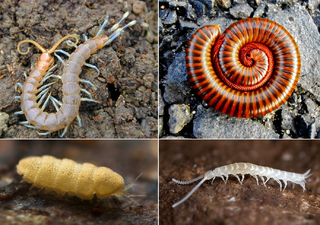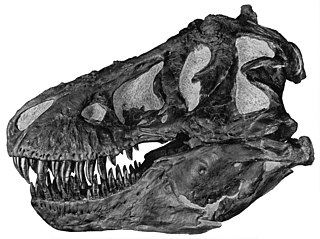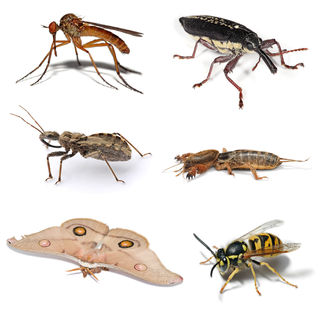
The subphylum Chelicerata constitutes one of the major subdivisions of the phylum Arthropoda. It contains the sea spiders, arachnids, and several extinct lineages, such as the eurypterids.

Rickettsia is a genus of nonmotile, Gram-negative, non-spore-forming, highly pleomorphic bacteria that may occur in the forms of cocci 0.1 μm in diameter, rods 1–4 μm long, or threads of up to about 10 μm long. The term "rickettsia" has nothing to do with rickets, which is a deficiency disease resulting from lack of vitamin D; the bacterial genus Rickettsia was named after Howard Taylor Ricketts, in honour of his pioneering work on tick-borne spotted fever.

The chelicerae are the mouthparts of the Chelicerata, an arthropod group that includes arachnids, horseshoe crabs, and sea spiders. Commonly referred to as "jaws", some chelicerae, such as those found in spiders, are hollow and contain venom glands, and are used to inject venom into prey or a (perceived) threat.

The hobo spider is a member of the genus of spiders known colloquially as funnel web spiders, but not to be confused with the Australian funnel-web spider. Individuals construct a funnel-shaped structure of silk sheeting and lie in wait at the small end of the funnel for prey insects to blunder onto their webs. Hobo spiders sometimes build their webs in or around human habitations.

Scutigera coleoptrata is a small, typically yellowish-grey centipede with up to 15 pairs of long legs. Originating in the Mediterranean region, the species has spread to other parts of the world, where it can live in human homes, thus gaining the name house centipede. It is an insectivore; it kills and eats other arthropods, such as insects and arachnids.

Myriapoda is a subphylum of arthropods containing millipedes, centipedes, and others. The group contains over 16,000 species, most of which are terrestrial. Although their name suggests they have myriad (10,000) legs, myriapods range from having up to 750 legs to having fewer than ten legs.

A stinger, or sting, is a sharp organ found in various animals capable of injecting venom, usually by piercing the epidermis of another animal.

Scolopendra heros, commonly known as the giant desert centipede, giant Sonoran centipede, Texas redheaded centipede, and giant redheaded centipede, is a species of North American centipede found in the Southwestern United States and Northern Mexico.

The Goliath birdeater belongs to the tarantula family Theraphosidae. Found in northern South America, it is the largest spider in the world by mass and size, but it is second to the giant huntsman spider by leg span. It is also called the Goliath bird-eating spider; the practice of calling theraphosids "bird-eating" derives from an early 18th-century copper engraving by Maria Sibylla Merian that shows one eating a hummingbird. Despite the spider's name, it only rarely preys on birds.

The Rickettsiaceae are a family of bacteria. The genus Rickettsia is the most prominent genus within the family. From this family, the bacteria that eventually formed the mitochondrion is believed to have originated. Most human pathogens in this family are in genus Rickettsia. They spend part of their lifecycle in the bodies of arthropods such as ticks or lice, and are then transmitted to humans or other mammals by the bite of the arthropod. It contains Gram-negative bacteria, very sensitive to environmental exposure, thus is adapted to obligate intracellular infection. Rickettsia rickettsii is considered the prototypical infectious organism in the group.

An animal bite is a wound, usually a puncture or laceration, caused by the teeth. An animal bite usually results in a break in the skin but also includes contusions from the excessive pressure on body tissue from the bite. The contusions can occur without a break in the skin. Bites can be provoked or unprovoked. Other bite attacks may be apparently unprovoked. Biting is a physical action not only describing an attack but it is a normal response in an animal as it eats, carries objects, softens and prepares food for its young, removes ectoparasites from its body surface, removes plant seeds attached to its fur or hair, scratching itself, and grooming other animals. Animal bites often result in serious infections and mortality. Animal bites not only include injuries from the teeth of reptiles, mammals, but fish, and amphibians. Arthropods can also bite and leave injuries.

Insect bites and stings occur when an insect is agitated and seeks to defend itself through its natural defense mechanisms, or when an insect seeks to feed off the bitten person. Some insects inject formic acid, which can cause an immediate skin reaction often resulting in redness and swelling in the injured area. Stings from fire ants, bees, wasps and hornets are usually painful, and may stimulate a dangerous allergic reaction called anaphylaxis for at-risk patients, and some wasps can also have a powerful bite along with a sting. Bites from mosquitoes and fleas are more likely to cause itching than pain.

Anthocoridae is a family of bugs, commonly called minute pirate bugs or flower bugs. Worldwide there are 500-600 species.

The discipline of medical entomology, or public health entomology, and also veterinary entomology is focused upon insects and arthropods that impact human health. Veterinary entomology is included in this category, because many animal diseases can "jump species" and become a human health threat, for example, bovine encephalitis. Medical entomology also includes scientific research on the behavior, ecology, and epidemiology of arthropod disease vectors, and involves a tremendous outreach to the public, including local and state officials and other stake holders in the interest of public safety, finally in current situation related to one health approach mostly health policy makers recommends to widely applicability of medical entomology for disease control efficient and best fit on achieving development goal and to tackle the newly budding zoonotic diseases. Thoughtful to have and acquaint with best practice of Med. Entomologist to tackle the animal and public health issues together with controlling arthropods born diseases by having Medical Entomologists’ the right hand for bringing the healthy world [Yon w].

In epidemiology, a disease vector is any agent who carries and transmits an infectious pathogen into another living organism; most agents regarded as vectors are organisms, such as intermediate parasites or microbes, but it could be an inanimate medium of infection such as dust particles.

Spiders are air-breathing arthropods that have eight legs and chelicerae with fangs able to inject venom. They are the largest order of arachnids and rank seventh in total species diversity among all orders of organisms. Spiders are found worldwide on every continent except for Antarctica, and have become established in nearly every habitat with the exceptions of air and sea colonization. As of November 2015, at least 45,700 spider species, and 113 families have been recorded by taxonomists. However, there has been dissension within the scientific community as to how all these families should be classified, as evidenced by the over 20 different classifications that have been proposed since 1900.

Jerome Goddard is an American entomologist currently located at Mississippi State University who is known for research on a number of medically important arthropods, most notably ticks and the common bed bug. His work on the health effects of bed bugs has helped clarify the pathophysiology of cutaneous reactions to their bites., Prior to coming to Mississippi State, Dr. Goddard was an Air Force medical entomologist for 3 years and then State Medical Entomologist for the Mississippi Department of Health for 20 years. After Hurricane Katrina (2005), Dr. Goddard was the health department official responsible for the mosquito and vector control program along the Mississippi Gulf Coast. He is the author of a medical textbook used by physicians which won "Highly Commended" in 2003 in the British Medical Association's Best Medical Book of the Year competition. Over the last two decades Dr. Goddard has served as an educational resource concerning medically important arthropods to a U.S. Congressional Committee, in various newspapers and magazines such as Reader's Digest, and on television programs such as The Learning Channel and the Colbert Report.

Biting is a common behavior which involves the opening and closing of the jaw found in many animals. This behavior is found in reptiles, mammals, fish and amphibians. Arthropods can also bite. Biting is a physical action in an attack but it is also a normal activity or response in an animal as it eats, carries objects, softens and prepares food for its young, removes ectoparasites from its body surface, removes plant seeds attached to its fur or hair, scratching itself, and grooming other animals and for defense. Animal bites often result in serious infections and death. Dog bites are commonplace, with human children the most commonly bitten and the face being the most common target.



















